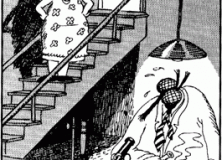Hat-tip to SK for this.
Two recent papers demonstrate that cultural evolution can be studied in the common fly. Battesti et al. (2012) show that Drosophila use social information when deciding where to lay their eggs:
“Taken altogether, these experiments show that D. melanogaster rely more heavily on social information than on personal information when both co-occur and even when they already have personal experience in the environment. When choosing between two equally rewarding oviposition media during the test phase of our experiments, observers tended to emulate the choice of demonstrators with which they spent time during the transmission phase. Considering the short lifespan of Drosophila in nature, rapidly adopting the behavior of the majority may provide an individual with cues to choices that are locally adaptive and prevent costly trial and error.”
In another blow to humanity, Stoop et al. (2012) (in the brilliantly titled ‘Fly outsmarts man’) claim that an analysis of the mating rituals of Drosophila demonstrate that their body-language has a formal power equal to that of human langauge. They demonstrate that the sequence of moves in their dances cannot be captured by a regular grammar (a random walk on states of a finite automaton), but must be at least context-free – the same complexity as human speech. In fact, the sequences from males were better captured by a context-sensitive grammar – one step up from us puny humans. They conclude that “human intellect cannot be the direct consequence of the formal grammar complexity of human language”.
I discover these experiments on the day of the Not Another Lost Generation demonstration against austerity measures which will affect the employment opportunities of young people and students. And now it seems that we don’t need human experiment participants any more.
Ruedi Stoop, Patrick Nüesch, Ralph Lukas Stoop, Leonid Bunimovich (2012). Fly out-smarts man Populations and Evolution : 1202.5913v1
Battesti, M., Moreno, C., Joly, D., & Mery, F. (2012). Spread of Social Information and Dynamics of Social Transmission within Drosophila Groups Current Biology, 22 (4), 309-313 DOI: 10.1016/j.cub.2011.12.050

